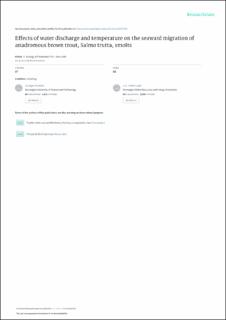| dc.contributor.author | Hembre, B. | |
| dc.contributor.author | Arnekleiv, J.V. | |
| dc.contributor.author | L’Abée-Lund, Jan Henning | |
| dc.coverage.spatial | Norway | en_US |
| dc.date.accessioned | 2021-04-21T08:00:21Z | |
| dc.date.available | 2021-04-21T08:00:21Z | |
| dc.date.issued | 2001 | |
| dc.identifier.issn | 0906-6691 | |
| dc.identifier.uri | https://hdl.handle.net/11250/2738768 | |
| dc.description.abstract | The smolt run of anadromous brown trout (Sulmo trutta) in a Norwegian river was studied for three consecutive years. The main run occurred in a period of 7–10 days in the middle or second half of May. Support was found for the hypothesis that high water discharge and temperature triggered the run. Few smolts descended when the discharge was low (<50 m3· s−1) and the water temperature was below 4°C. The maximum number were caught when the discharge was moderate (70–150 m3· s−1) and the water temperature high (68°C). The relative importance of these factors varied from year to year. The first-year discharge explained 38% of the variation in the number of smolts migrating. Discharge and temperature together explained 61% in 1992 and 28% in the second and third year, respectively. | en_US |
| dc.subject | Anadromous brown trout (Salmo trutta) | en_US |
| dc.subject | Smolt migration | en_US |
| dc.subject | Water discharge | en_US |
| dc.subject | Temperature | en_US |
| dc.title | Effects of water discharge and temperature on the seaward migration of anadromous brown trout, Salmo trutta, smolts | en_US |
| dc.type | Journal article | en_US |
| dc.source.pagenumber | 61-64 | en_US |
| dc.source.journal | Ecology of Freshwater Fish | en_US |
| dc.source.issue | 10 | en_US |
